Nikolaos Aletras
Analysing Chain of Thought Dynamics: Active Guidance or Unfaithful Post-hoc Rationalisation?
Aug 27, 2025Abstract:Recent work has demonstrated that Chain-of-Thought (CoT) often yields limited gains for soft-reasoning problems such as analytical and commonsense reasoning. CoT can also be unfaithful to a model's actual reasoning. We investigate the dynamics and faithfulness of CoT in soft-reasoning tasks across instruction-tuned, reasoning and reasoning-distilled models. Our findings reveal differences in how these models rely on CoT, and show that CoT influence and faithfulness are not always aligned.
Progressive Depth Up-scaling via Optimal Transport
Aug 11, 2025Abstract:Scaling Large Language Models (LLMs) yields performance gains but incurs substantial training costs. Depth up-scaling offers training efficiency by adding new layers to pre-trained models. However, most existing methods copy or average weights from base layers, neglecting neuron permutation differences. This limitation can potentially cause misalignment that harms performance. Inspired by applying Optimal Transport (OT) for neuron alignment, we propose Optimal Transport Depth Up-Scaling (OpT-DeUS). OpT-DeUS aligns and fuses Transformer blocks in adjacent base layers via OT for new layer creation, to mitigate neuron permutation mismatch between layers. OpT-DeUS achieves better overall performance and offers improved training efficiency than existing methods for continual pre-training and supervised fine-tuning across different model sizes. To further evaluate the impact of interpolation positions, our extensive analysis shows that inserting new layers closer to the top results in higher training efficiency due to shorter back-propagation time while obtaining additional performance gains.
Enhancing Logical Reasoning in Language Models via Symbolically-Guided Monte Carlo Process Supervision
May 26, 2025Abstract:Large language models (LLMs) have shown promising performance in mathematical and logical reasoning benchmarks. However, recent studies have pointed to memorization, rather than generalization, as one of the leading causes for such performance. LLMs, in fact, are susceptible to content variations, demonstrating a lack of robust symbolic abstractions supporting their reasoning process. To improve reliability, many attempts have been made to combine LLMs with symbolic methods. Nevertheless, existing approaches fail to effectively leverage symbolic representations due to the challenges involved in developing reliable and scalable verification mechanisms. In this paper, we propose to overcome such limitations by generating symbolic reasoning trajectories and select the high-quality ones using a process reward model automatically tuned based on Monte Carlo estimation. The trajectories are then employed via fine-tuning methods to improve logical reasoning and generalization. Our results on logical reasoning benchmarks such as FOLIO and LogicAsker show the effectiveness of the proposed method with large gains on frontier and open-weight models. Moreover, additional experiments on claim verification reveal that fine-tuning on the generated symbolic reasoning trajectories enhances out-of-domain generalizability, suggesting the potential impact of symbolically-guided process supervision in alleviating the effect of memorization on LLM reasoning.
GreekBarBench: A Challenging Benchmark for Free-Text Legal Reasoning and Citations
May 22, 2025Abstract:We introduce GreekBarBench, a benchmark that evaluates LLMs on legal questions across five different legal areas from the Greek Bar exams, requiring citations to statutory articles and case facts. To tackle the challenges of free-text evaluation, we propose a three-dimensional scoring system combined with an LLM-as-a-judge approach. We also develop a meta-evaluation benchmark to assess the correlation between LLM-judges and human expert evaluations, revealing that simple, span-based rubrics improve their alignment. Our systematic evaluation of 13 proprietary and open-weight LLMs shows that even though the best models outperform average expert scores, they fall short of the 95th percentile of experts.
Compressing Language Models for Specialized Domains
Feb 25, 2025Abstract:Compression techniques such as pruning and quantization offer a solution for more efficient deployment of language models (LMs), albeit with small performance drops in benchmark performance. However, general-purpose LM compression methods can negatively affect performance in specialized domains (e.g. biomedical or legal). Recent work has sought to address this, yet requires computationally expensive full-parameter fine-tuning. To this end, we propose cross-calibration, a novel training-free approach for improving the domain performance of compressed LMs. Our approach effectively leverages Hessian-based sensitivity to identify weights that are influential for both in-domain and general performance. Through extensive experimentation, we demonstrate that cross-calibration substantially outperforms existing approaches on domain-specific tasks, without compromising general performance. Notably, these gains come without additional computational overhead, displaying remarkable potential towards extracting domain-specialized compressed models from general-purpose LMs.
How Private are Language Models in Abstractive Summarization?
Dec 16, 2024Abstract:Language models (LMs) have shown outstanding performance in text summarization including sensitive domains such as medicine and law. In these settings, it is important that personally identifying information (PII) included in the source document should not leak in the summary. Prior efforts have mostly focused on studying how LMs may inadvertently elicit PII from training data. However, to what extent LMs can provide privacy-preserving summaries given a non-private source document remains under-explored. In this paper, we perform a comprehensive study across two closed- and three open-weight LMs of different sizes and families. We experiment with prompting and fine-tuning strategies for privacy-preservation across a range of summarization datasets across three domains. Our extensive quantitative and qualitative analysis including human evaluation shows that LMs often cannot prevent PII leakage on their summaries and that current widely-used metrics cannot capture context dependent privacy risks.
Vocabulary Expansion of Chat Models with Unlabeled Target Language Data
Dec 16, 2024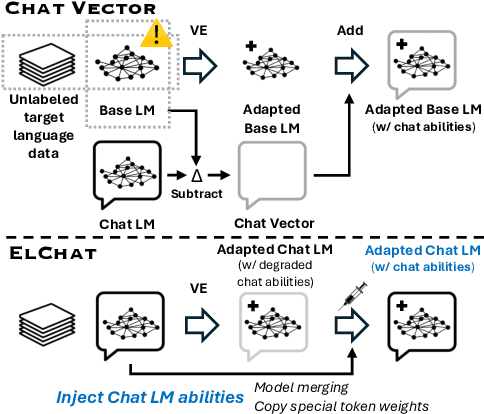
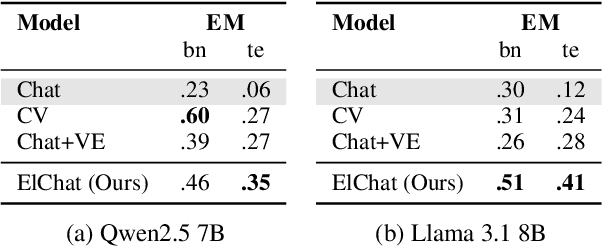
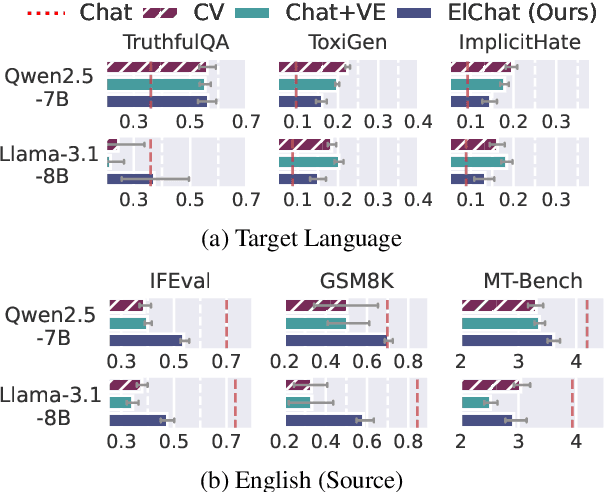

Abstract:Chat models (i.e. language models trained to follow instructions through conversation with humans) outperform base models (i.e. trained solely on unlabeled data) in both conversation and general task-solving abilities. These models are generally English-centric and require further adaptation for languages that are underrepresented in or absent from their training data. A common technique for adapting base models is to extend the model's vocabulary with target language tokens, i.e. vocabulary expansion (VE), and then continually pre-train it on language-specific data. Using chat data is ideal for chat model adaptation, but often, either this does not exist or is costly to construct. Alternatively, adapting chat models with unlabeled data is a possible solution, but it could result in catastrophic forgetting. In this paper, we investigate the impact of using unlabeled target language data for VE on chat models for the first time. We first show that off-the-shelf VE generally performs well across target language tasks and models in 71% of cases, though it underperforms in scenarios where source chat models are already strong. To further improve adapted models, we propose post-hoc techniques that inject information from the source model without requiring any further training. Experiments reveal the effectiveness of our methods, helping the adapted models to achieve performance improvements in 87% of cases.
Self-calibration for Language Model Quantization and Pruning
Oct 22, 2024



Abstract:Quantization and pruning are fundamental approaches for model compression, enabling efficient inference for language models. In a post-training setting, state-of-the-art quantization and pruning methods require calibration data, a small set of unlabeled examples. Conventionally, randomly sampled web text is used, aiming to reflect the model training data. However, this poses two key problems: (1) unrepresentative calibration examples can harm model performance, and (2) organizations increasingly avoid releasing model training data. In this paper, we propose self-calibration as a solution. Our approach requires no external data, instead leveraging the model itself to generate synthetic calibration data as a better approximation of the pre-training data distribution. We extensively compare the performance of self-calibration with several baselines, across a variety of models, compression methods, and tasks. Our approach proves consistently competitive in maximizing downstream task performance, frequently outperforming even using real data.
Enhancing Data Quality through Simple De-duplication: Navigating Responsible Computational Social Science Research
Oct 04, 2024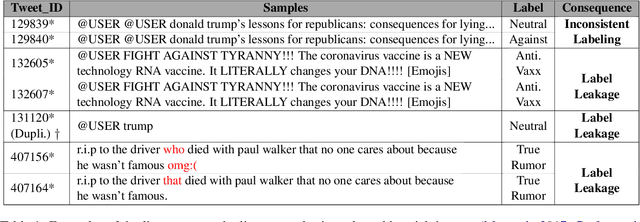

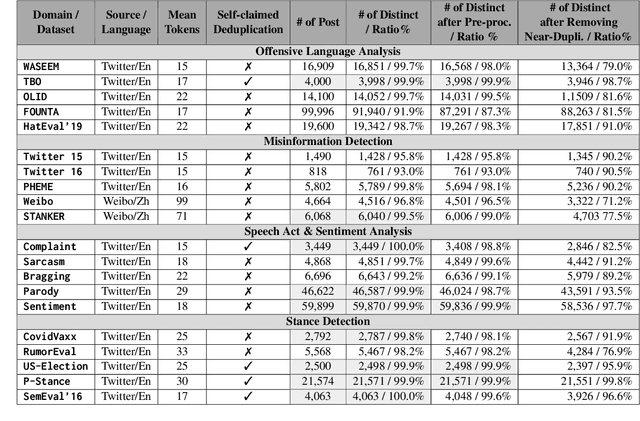

Abstract:Research in natural language processing (NLP) for Computational Social Science (CSS) heavily relies on data from social media platforms. This data plays a crucial role in the development of models for analysing socio-linguistic phenomena within online communities. In this work, we conduct an in-depth examination of 20 datasets extensively used in NLP for CSS to comprehensively examine data quality. Our analysis reveals that social media datasets exhibit varying levels of data duplication. Consequently, this gives rise to challenges like label inconsistencies and data leakage, compromising the reliability of models. Our findings also suggest that data duplication has an impact on the current claims of state-of-the-art performance, potentially leading to an overestimation of model effectiveness in real-world scenarios. Finally, we propose new protocols and best practices for improving dataset development from social media data and its usage.
Vocabulary Expansion for Low-resource Cross-lingual Transfer
Jun 17, 2024Abstract:Large language models (LLMs) have shown remarkable capabilities in many languages beyond English. Yet, LLMs require more inference steps when generating non-English text due to their reliance on English-centric tokenizers, vocabulary, and pre-training data, resulting in higher usage costs to non-English speakers. Vocabulary expansion with target language tokens is a widely used cross-lingual vocabulary adaptation approach to remedy this issue. Despite its effectiveness in inference speedup, the majority of previous work has focused on high-resource settings assuming access to a substantial amount of target language data to effectively initialize the embeddings of the new tokens and adapt the LLM to the target language. However, vocabulary expansion for LLMs in low-resource settings (i.e. languages and compute) has yet to be explored. In this paper, we investigate sample-efficient adaptation strategies from different angles, including target vocabulary size and initialization methods, and the amount of target data available for adaptation. Extensive experiments across typologically diverse languages, tasks and models show that simpler heuristic-based embedding initialization is more efficient and robust to changes in target vocabulary size and adaptation data in low-resource settings, outperforming a popular random initialization and a more sophisticated state-of-the-art approach that relies on external data and model.
 Add to Chrome
Add to Chrome Add to Firefox
Add to Firefox Add to Edge
Add to Edge